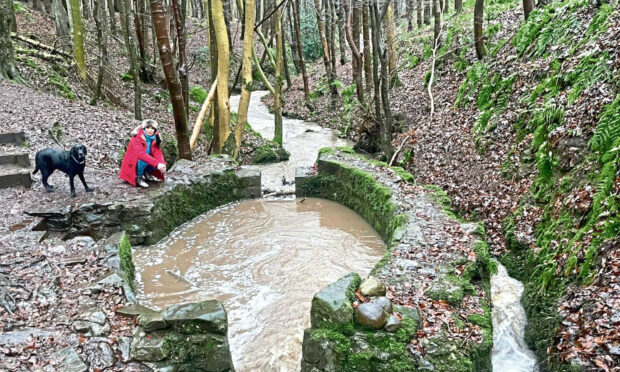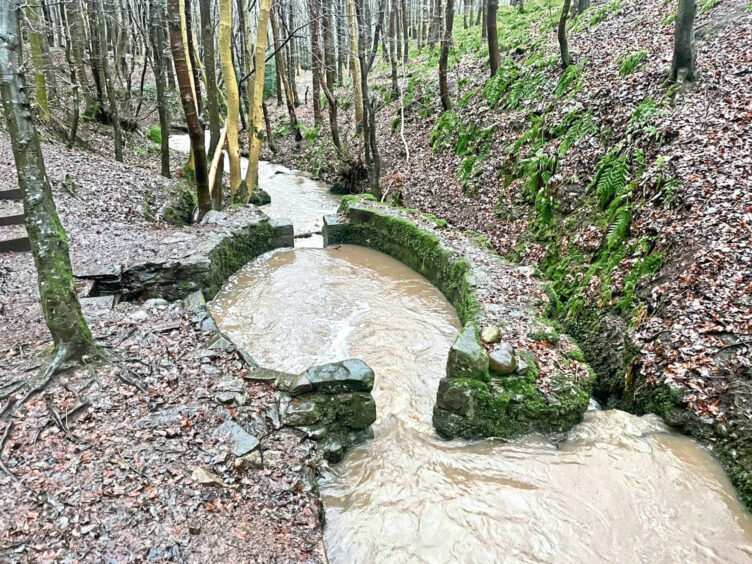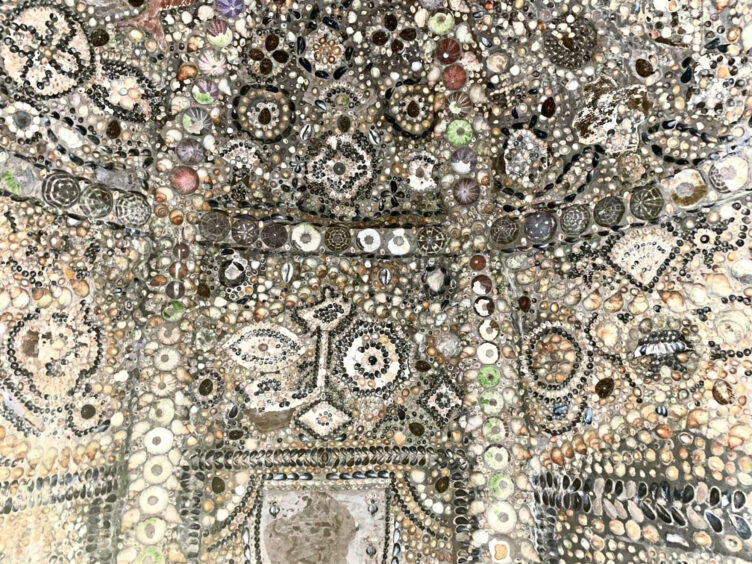Gayle explores the woodlands of Dunnottar House and discovers its intriguing history.
If it hadn’t been for the fact that the water was rather brown, murky and fast-flowing, I’d have taken a dip.
It didn’t help that it was 2C, raining and I hadn’t brought my swimsuit.
In all honesty, the prospect of having a goosebump-inducing soak in Lady Kennedy’s bath at the tail end of December simply did not appeal. So I stayed put on dry land and simply gazed at the intriguing looking oval-shaped stone structure instead.
I’d come for a wander through Dunnottar Woods on a wet winter’s afternoon and the bath was among several fascinating features to be found among the trees.
It’s named Lady Kennedy’s Bath after the laird’s wife, Lady Eleanor Kennedy, who swam here in the early 19th Century with her children.
The long-gone sluices would have controlled the water, diverting it from the burbling Glasslaw Burn to create a pool for bathing.
I may return for a splash-around one day, perhaps in the spring or summer.
Another fantastic landmark close by is a folly known as the “Shell Hoosie”, built around 1820.
Tucked deep in the woods, this cute summer house, shaped rather like a beehive, is thought to have been built as a grotto for Lady Kennedy’s kids.
A padlocked metal gate prevents you from getting inside, but I shone my torch around and was delighted to see that the walls and interior were decorated with thousands of seashells of all shapes, colours and sizes.
A plaque explains that the folly fell into disrepair during the 20th Century and was largely forgotten. And to be fair, I’d never been remotely aware of it until now.
In 1999, Dunnottar Woodland Park Association, with help from the Heritage Lottery Fund, restored the folly to its former glory.
During reconstruction, strange outerworks were unearthed including a small round brick-built pool and a water jet.
This wee pool still fills with water, but there’s no sign of the water jet.
Incredibly, Lady Kennedy was said to have had 10 of these shell structures erected, but this appears to be the only one still visible.
However, dotted throughout the woods are 23 cute fairy doors attached to tree stumps and trunks. If you’re really keen on fairies you can download a map from the Dunnottar Fairy Trail Facebook page and hunt them all down.
I spotted four and knocked on the doors but sadly no fairies answered.
Heading through a corridor of trees, a signpost invites you to discover “one of Stonehaven’s most grisly secrets” on Gallow Hill and follow a path to the top “once trod by the town’s condemned criminals as they took their final walk”. Nice.
The hill is thought to have been an early Bronze Age cairn dating from around 2000BC and is a scheduled monument. However, it became a place of execution in the 1600s.
An information board reveals that not every convict dragged up the hill was hanged. No siree. Rather, some received a kick in the rear from Stonehaven’s hangmaster, or “doom-master”.
In 1700, Alexander Matheson and Christian Welsh apparently suffered this humiliating punishment for harbouring a fugitive who had stolen “two cravats, a coat and some green yarn”.
There’s not much to see at the summit other than a grille covering the entrance to an ice house, once used to store perishable food by the residents of Dunnottar House. Just be careful you don’t stumble into what remains of this, or over any trees felled by Storm Arwen.
You can’t miss the huge walls of the Dunnottar Nursery – once the walled garden attached to the house – and very much still standing proud.
Nearby Dunnottar churchyard is also worth checking out. As well as boasting a skull in the wall (rather unsettling), it has a memorial called The Covenanter’s Stone which commemorates those who died in one of the’s darkest episodes in Scottish history.
In 1685, in a fervour of religious turmoil in Scotland, 167 Presbyterian dissenters were imprisoned in Dunnottar Castle because they refused to recognise the king’s pre-eminence in religious affairs.
These “Whigs” were held with minimal food, water and sanitation for two months in a cramped cell that became known as the Whigs’ Vault.
Eventually 37 prisoners swore an allegiance to the king and were released, 25 escaped, although 15 were recaptured, and two fell from the cliffs to their deaths.
Five prisoners died, and those who survived were deported to the West Indies, but as many as 70 died during the journey.
Sure, Dunnottar has some tragic tales to tell but a wander in the woods (and a refreshing bath if you’re really brave) is well worth it.
- Dunnottar Woods and House were created around in 1800 for merchant and slaver trader Alexander Allardyce. Having made his fortune in Jamaica, Allardyce returned to Aberdeen a wealthy man in the early 1780s, became Lord Rector of Marischal College and was elected as the member of parliament for the Aberdeen Burghs in 1792. To commemorate his success, he purchased the lands of Dunnottar, near Stonehaven, which had been forfeited by the Earls Marischal – once one of the most powerful families in Scotland – in the 1715 Jacobite rising.
- Dunnottar House was demolished in 1959 but the woodlands still stand and are, to some minds, a legacy of Allardyce’s Caribbean wealth.
- His daughter was Eleanor Allardyce, who married Lord William Kennedy to become Lady Kennedy.















